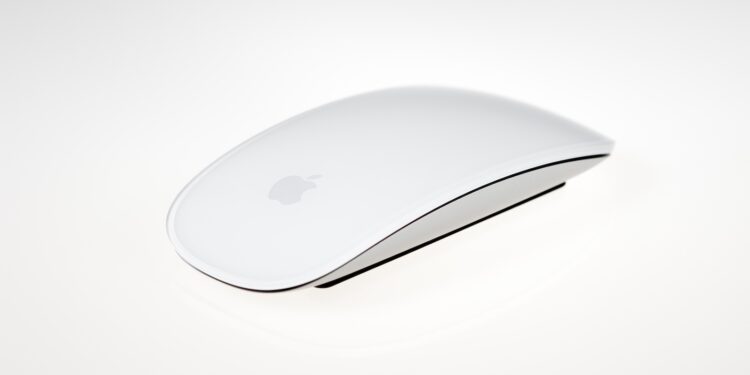Apple is apparently working on a new version of the Magic Mouse. This time, it's not about a new design or a better-placed charging port, but rather a fundamental change in operation: The mouse will be able to recognize gestures that you make not on the surface, but in the air next to the mouse. This will be made possible by a combination of sensors, cameras, and possibly even projectors.
If you use a Mac, you're probably already familiar with the Magic Mouse. It was introduced in 2009 and, with its multi-touch surface, enabled a new type of mouse control. Since then, there have been a few minor revisions, but no radical innovations. Now a new patent shows that Apple is thinking ahead. Mouse input could soon be expanded – with features previously only available with the Apple Vision Pro. For users, this could mean fewer clicks and more intuitive control.
Apple patent describes new control options
A newly filed and approved patent by Apple entitled "Electronic Devices with Enhanced Input and Output Functionality" describes a mouse that detects not only touch but also mid-air gestures. Specifically, sensors on the side of the device detect finger movements next to the mouse. This information is then used to control the Mac. The patent text states that a mouse or other pointing device could be equipped with multiple sensors attached to the side of the device. These sensors are designed to detect the position of your fingers in an area next to the mouse. This could include optical sensors, light sources such as LEDs or lasers, and light detectors. Apple also mentions capacitive sensors, similar to those found on touchscreens. The goal is to recognize so-called three-dimensional gestures.
- The Magic Mouse of the future could register movements of your hand through the air and derive input commands from them.
It would then be possible to trigger a function by simply swiping, pointing or clapping – without even touching the mouse.
Cameras, infrared sensors and even projectors are conceivable
The patent also describes how gesture recognition could be supported by visible light or infrared cameras. These could, for example, detect when you point your finger at a specific point on the table or navigate through a projected menu. The reference to projectors is also interesting. The mouse could project an image onto the table—such as virtual buttons or other controls. When you tap on this projected image, sensors or cameras would recognize your input. This could create a kind of virtual keyboard or control interface—right on your desk. The patent gives concrete examples: Visual elements such as file icons, menu items, alphanumeric keys, or even animated content could be projected. For example, if you tap on a folder icon, the system could recognize that you want to open this folder (via USPTO).
Not only for the Magic Mouse – technology also for other devices
Although the patent primarily relates to a mouse, Apple lists a number of other devices in which the technology could also be used. These include:
- Trackpads and other pointing devices
- laptop computer
- Monitors with integrated computer
- tablets
- smartphones
- Media player
- smartwatches
- Headphones or headsets
• Furniture such as desks or chairs
This makes it conceivable that in the future, you could execute a command with a hand gesture next to your desk – or that a desk could respond to your finger movements. According to the patent, even setting down a coffee cup could trigger a specific action, such as activating your Mac.
How the Magic Mouse could handle gestures
According to Apple, the new technology could be a useful addition to existing input options. The recognized gestures will be used together with data from buttons, touch sensors, and motion sensors to interpret your inputs more precisely. For example, you could:
- Open a menu with a swipe in the air
- Zoom by spreading your fingers
- move the cursor without touching the mouse
- activate a virtual button by pointing at it
- Confirm or reject an action by a hand signal
An example from the patent: You click on “Bid” in an online auction and then use a gesture in the air to indicate how high you want your bid to be.
No finished product yet – but concrete ideas
As with many patents, just because a patent exists doesn't mean Apple will actually implement the concept. However, it does show that Apple is working on new input methods that go beyond what current devices can do. The fact that the patent covers so many different device categories suggests that Apple intends to use the technology in a variety of ways—not just in a redesigned Magic Mouse.
The next Magic Mouse could be more than just a mouse
The Magic Mouse could become a central control device in the future—not just for your Mac, but for an entire ecosystem of input devices. Gesture control in the air, projections on the table, and sensor-based inputs could make operation more natural and flexible. Whether and when this technology will actually appear in an Apple product remains to be seen. But the patent clearly shows: The classic mouse as you know it may be facing a major transformation. The best products for you: Our Amazon Storefront offers a wide selection of accessories, including HomeKit. (Image: Shutterstock / Tamisclao)
- Apple Vision Pro could get an action button
- Apple plans fall detection for glasses and contact lenses
- Foldable Apple Watch? New patent provides clues





